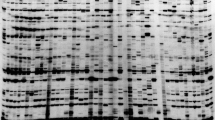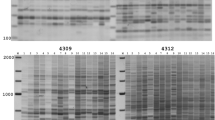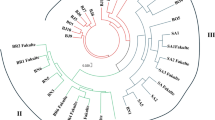Abstract
The Sequence-Specific Amplification Polymorphism (S-SAP) method, and the related molecular marker techniques IRAP (inter-retrotransposon amplified polymorphism) and REMAP (retrotransposon-microsatellite amplified polymorphism), are based on retrotransposon activity, and are increasingly widely used. However, there have been no systematic analyses of the parameters of these methods or of the utility of different retrotransposon families in producing polymorphic, scorable fingerprints. We have generated S-SAP, IRAP, and REMAP data for three barley ( Hordeum vulgare L.) varieties using primers based on sequences from six retrotransposon families ( BARE -1, BAGY-1, BAGY-2, Sabrina, Nikita and Sukkula). The effect of the number of selective bases on the S-SAP profiles has been examined and the profiles obtained with eight MseI+3 selective primers compared for all the elements. Polymorphisms detected in the insertion pattern of all the families show that each can be used for S-SAP. The uniqueness of each transposition event and differences in the historic activity of each family suggest that the use of multiple retrotransposon families for genetic analysis will find applications in mapping, fingerprinting, and marker-assisted selection and evolutionary studies, not only in barley and other Hordeum species and related taxa, but also more generally.



Similar content being viewed by others
References
Boeke JD, Corces VG (1989) Transcription and reverse transcription of retrotransposons. Annu Rev Microbiol 43:403–434
Boeke JD, Garfinkel DJ, Styles CA, Fink GR (1985) Ty elements transpose through an RNA intermediate. Cell 40:491–500
Boyko E, Kalendar R, Korzun V, Korol A, Schulman AH, Gill BS (2002) A high-density cytogenetic map of the Aegilops tauschii genome incorporating retrotransposons and defence related genes: insights into cereal chromosome structure and function. Plant Mol Biol 48:767–790
Ellis THN, Poyser SJ, Knox MR, Vershinin AV, Ambrose MJ (1998) Polymorphism of insertion sites of Ty1-copia class retrotransposons and its use for linkage and diversity analysis in pea. Mol Gen Genet 260:9–19
Fedoroff N (2000) Transposons and genome evolution in plants. Proc Natl Acad Sci USA 97:7002–7007
Gribbon BM, Pearce SR, Kalendar R, Schulman AH, Paulin L, Jack PL, Kumar A, Flavell AJ (1999) Phylogeny and transpositional activity of Ty1-copia group retrotransposons in cereal genomes. Mol Gen Genet 261:883–891
Jääskeläinen M, Mykkänen A-H, Arna T, Vicient C, Suoniemi A, Kalendar R, Savilahti H, Schulman AH (1999) Retrotransposon BARE -1: expression of encoded proteins and formation of virus-like particles in barley cells. Plant J 20:413–422
Jackson JA, Matthews D (2000) A modified inter-SSR PCR protocol for use in conjunction with the LI-COR Gene ReadIR 4200 DNA analyser. Biotechniques 28:914–920
Kalendar R, Grob T, Regina M, Suoniemi A, Schulman A (1999) IRAP and REMAP: two new retrotransposon-based DNA fingerprinting techniques. Theor App Gen 98:704–711
Kalendar R, Tanskanen J, Immonen S, Nevo E, Schulman AH (2000) Genome evolution of wild barley ( Hordeum spontaneum) by BARE -1 retrotransposon dynamics in response to sharp microclimatic divergence. Proc Natl Acad Sci USA 97:6603–6607
Kumar A, Bennetzen J (1999) Plant retrotransposons. Annu Rev Genet 33:479–532
Kumar A, Pearce SR, McLean K, Harrison G, Heslop-Harrison JS, Waugh R, Flavell AJ (1997) The Ty1-copia group of retrotransposons in plants: genomic organisation, evolution, and use as molecular markers. Genetica 100:205–217
Lee D, Ellis THN, Turner L, Hellens RP, Cleary WG (1990) A copia-like element in Pisum demonstrates the uses of dispersed repeated sequences in genetic analysis. Plant Mol Biol 15:707–722
Manninen I, Schulman AH (1993) BARE -1, a copia -like retroelement in barley ( Hordeum vulgare L.). Plant Mol Biol 22:829–846.
Manninen O, Kalendar R, Robinson J, Schulman AH (2000) Application of BARE -1 retrotransposon markers to the mapping of a major resistance gene for net blotch in barley. Mol Gen Genet 264:325–334
Panstruga R, Büschges R, Piffanelli P, Schulze-Lefert P (1999) A contiguous 60 kb genomic stretch from barley reveals molecular evidence for gene islands in a monocot genome. Nucleic Acids Res 26:1056–1062
Porceddu A, Albertini E, Baracaccia G, Marconi, G, Bertoli FB, Veronesi, F (2002) Development of S-SAP markers based on an LTR-like sequence from Medicago sativa L. Mol Gen Genet 267:107–114
SanMiguel P, Tikhonov A, Jin YK, Motchoulskaia N, Zakharov D, Melake-Berhan A, Springer PS, Edwards KJ, Lee M, Avramova Z, Bennetzen JL (1996) Nested retrotransposons in the intergenic regions of the maize genome. Science 274:765–768
Shirasu K, Schulman AS, Lahaye T, Schulze-Lefert P (2000) A contiguous 66-kb barley DNA sequence provides evidence for reversible genome expansion. Genome Res 10:908–915
Suoniemi A, Narvanto A, Schulman AH (1996) The BARE -1 retrotransposon is transcribed in barley from an LTR promoter active in transient assays. Plant Mol Biol 31:295–306
Suoniemi A, Schmidt D, Schulman, AH (1997) BARE -1 insertion site preferences and evolutionary conservation of RNA and cDNA processing sites. Genetica 100:219–230
Vicient CM, Suoniemi A, Anamthawat-Jónsson K, Tanskanen J, Beharav A, Nevo E, Schulman AH (1999) Retrotransposon BARE -1 and its role in genome evolution in the genus Hordeum. Plant Cell 11:1769–1784
Vicient CM, Kalendar R, Schulman AH (2001) Envelope-class retrovirus-like elements are widespread, transcribed and spliced, and insertionally polymorphic in plants. Genome Res 11:2041–2049
Vos P, Hogers R, Bleeker M, Reijans M, van der Lee T, Hornes M, Frijters A, Pot J, Peleman J, Kuiper M, Zabeau M (1995) AFLP: a new technique for DNA fingerprinting. Nucleic Acids Res 23:4407–4414
Waugh R, McLean K, Flavell AJ, Pearce SR, Kumar A, Thomas BBT, Powell W (1997) Genetic distribution of BARE -1-like retrotransposable elements in the barley genome revealed by sequence-specific amplification polymorphisms (S-SAP). Mol Gen Genet 253:687–694
Wei F, Wing RA, Wise RP (2002) Genome dynamics and evolution of the Mla (powdery mildew) resistance locus in barley. Plant Cell 14:1903–1917
Xiong Y, Eickbush TH (1990) Origin and evolution of retroelements based upon their reverse transcriptase sequences. EMBO J 9:3353–3362
Acknowledgements
This work was funded by the European Union FP5 initiative projects QLRT-1999-PL1499 and QLK5-CT-2000-01502. DNA was kindly provided by Keygene NV (Wageningen, The Netherlands). The authors wish to thank the two anonymous referees and the Communicating Editor for helpful comments on the manuscript
Author information
Authors and Affiliations
Corresponding author
Additional information
Communicated by M.-A. Grandbastien
Rights and permissions
About this article
Cite this article
Leigh, F., Kalendar, R., Lea, V. et al. Comparison of the utility of barley retrotransposon families for genetic analysis by molecular marker techniques. Mol Gen Genomics 269, 464–474 (2003). https://doi.org/10.1007/s00438-003-0850-2
Received:
Accepted:
Published:
Issue Date:
DOI: https://doi.org/10.1007/s00438-003-0850-2




